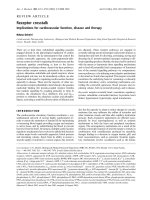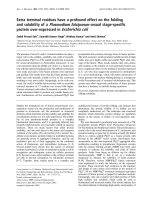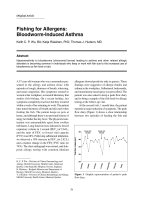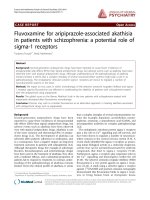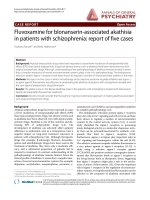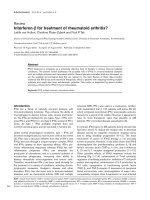Báo cáo y học: "Receptor for advanced glycation end products Glycine 82 Serine polymorphism and risk of cardiovascular events in rheumatoid arthritis" potx
Bạn đang xem bản rút gọn của tài liệu. Xem và tải ngay bản đầy đủ của tài liệu tại đây (151.37 KB, 8 trang )
Open Access
Available online />Page 1 of 8
(page number not for citation purposes)
Vol 9 No 2
Research article
Receptor for advanced glycation end products Glycine 82 Serine
polymorphism and risk of cardiovascular events in rheumatoid
arthritis
Lisa Carroll
1
, Ian H Frazer
1
, Malcolm Turner
1
, Thomas H Marwick
2
and Ranjeny Thomas
1
1
Diamantina Institute for Cancer, Immunology and Metabolic Medicine, University of Queensland, Princess Alexandra Hospital, Ipswich Road,
Brisbane, Queensland 4102, Australia
2
Department of Medicine, University of Queensland, Princess Alexandra Hospital, Ipswich Road, Brisbane, Queensland 4102, Australia
Corresponding author: Ranjeny Thomas,
Received: 18 Oct 2006 Revisions requested: 23 Nov 2006 Revisions received: 20 Mar 2007 Accepted: 11 Apr 2007 Published: 11 Apr 2007
Arthritis Research & Therapy 2007, 9:R39 (doi:10.1186/ar2175)
This article is online at: />© 2007 Carroll et al.; licensee BioMed Central Ltd.
This is an open access article distributed under the terms of the Creative Commons Attribution License ( />),
which permits unrestricted use, distribution, and reproduction in any medium, provided the original work is properly cited.
Abstract
Patients with rheumatoid arthritis (RA) are at risk of excess
mortality, predominantly owing to cardiovascular (CV) events.
The receptor for advanced glycation end products (RAGE) has
been implicated in the perpetuation of the chronic inflammatory
response in vascular disease. A Gly82→Ser polymorphism in
the RAGE gene, which is associated with enhanced RAGE
signaling, is present more frequently in patients with RA than the
general population. To investigate whether RAGE Gly82→Ser
polymorphism is associated with CV events in RA, we examined
CV events, CV risk factors, features of RA and RAGE
Gly82→Ser polymorphism in 232 patients with RA attending a
tertiary referral hospital. CV events, the duration and severity of
RA, and risk factors for CV disease were determined using
patient questionnaires, chart review, laboratory analysis and
radiographs. DNA was typed for HLA–DRB1 genes and RAGE
Gly82→Ser polymorphism. The RAGE Ser82 allele, which is in
linkage disequilibrium with the RA susceptibility allele HLA–
DRB1*0401, was carried by 20% of patients. More than 20%
of the cohort had suffered a vascular event; a shorter duration of
RA, but not the RAGE genotype, was significantly associated
with CV events. However, a history of statin use was protective.
Thus, the RAGE Ser82 allele, associated with enhanced RAGE
signaling, does not predispose to CV events in RA. However,
treatment of hyperlipidemia with statins reduces the probability
of a CV event.
Introduction
The mortality of patients with rheumatoid arthritis (RA) is
increased compared with the general population and most of
this increase can be attributed to excess cardiovascular (CV)
deaths [1]. Immune dysregulation and systemic inflammation
have important roles in the accelerated atherosclerosis of RA.
Serologic markers of inflammation, such as C-reactive protein
(CRP) and serum amyloid A, are strongly associated with CV
disease in the general population, in addition to systemic
inflammatory diseases, including RA, systemic lupus ery-
thematosus and inflammatory bowel disease [2-4]. Although
the INTERHEART study showed 90% to 94% of the risk of
myocardial infarction could be accounted for by conventional
risk factors (abnormal lipids, smoking, hypertension, diabetes,
abdominal obesity and inactivity), in addition to psychosocial
factors and diet [5], the contribution of inflammation is associ-
ated with these risk factors. Inflammation might potentiate a
prothrombotic inflammatory state, or promote metabolic and
psychosocial factors, which affect disease [6,7]. For example,
smoking is a risk factor for both CV disease and RA and itself
associated with the promotion of inflammation, characterized
by elevated CRP levels [8]. For patients with inflammatory pol-
yarthritis or RA, the baseline level of CRP or peak erythrocyte
ACR = American College of Rheumatology; AGE = advanced glycation end product; BMI = body-mass index; CCP = cyclic citrullinated peptide;
CrCl = creatinine clearance; CRP = C-reactive protein; CT = computed tomography; CV = cardiovascular; ECG = electrocardiogram; ESR = eryth-
rocyte sedimentation rate; HDL = high-density lipoprotein; HMGB1 = high-mobility group box chromosomal protein; HR = hazard ratio; LDL = low-
density lipoprotein; MAP = mitogen activated protein; MHC = major histocompatability; MI = myocardial infarction; NF-κB = nuclear factor of kappa
B; PCR = polymerase chain reaction; PVD = peripheral vascular disease; RA = rheumatoid arthritis; RF = rheumatoid factor; RAGE = receptor for
advanced glycation end products; SCr = serum creatinine; TG = triglyceride; TIA = transient ischemic attack; TNF = tumor necrosis factor; VLDL =
very-low-density lipoprotein.
Arthritis Research & Therapy Vol 9 No 2 Carroll et al.
Page 2 of 8
(page number not for citation purposes)
sedimentation rate (ESR) within the first year after onset has
been independently associated with the risk of CV death
[9,10]. Thus, the progress of CV disease might depend on the
burden of inflammation.
The receptor for advanced glycation end products (RAGE) is
a multiligand member of the immunoglobulin superfamily of
cell-surface receptor molecules encoded by chromosome 6 at
the major histocompatability locus (MHC) class II/III junction
[11]. When ligated, RAGE is implicated in atherogenesis and
chronic inflammatory diseases by amplifying inflammatory
events in tissues previously sensitized by lipid deposition or
inflammatory triggers [12]. RAGE is expressed at low levels in
normal tissues but upregulated at sites of vascular pathology
or severe injury [13,14]. RAGE ligands include the calgranulin
family of S100 proteins, the cytokine amphoterin (high-mobility
group box chromosomal protein (HMGB1)), β-pleated sheet
fibrils of amyloid and advanced glycation end products (AGEs)
[15]. AGEs are the products of nonenzymatic glycation and
oxidation of proteins that form with aging, diabetes and renal
failure, and at sites of inflammation (by oxidation) [16].
Levels of S100 proteins and HMGB1 are increased in both
adult and juvenile RA [17], and inhibition of the RAGE has
been shown to suppress inflammation in animal models of
arthritis [18]. There are four polymorphisms of the RAGE, of
which the Gly82→Ser functional dimorphism shows the high-
est prevalence [19]. Ser82 enhances receptor signaling
through mitogen activated protein (MAP) kinases and nuclear
factor of kappa B (NF-κB) [18]. The increased prevalence of
Ser82 in RA might be accounted for by linkage disequilibrium
with the RA-associated HLA–DRB1*0401 allele [11,18,20].
However, although RAGE has been implicated in atheroscle-
rosis, and the vascular component of diabetes mellitus and
renal disease, RAGE Gly82→Ser polymorphism showed no
association with CV disease in the general population [21].
Here, we tested whether the RAGE Gly82→Ser polymor-
phism was associated with CV events in RA.
Materials and methods
Patients
All current cases of RA, which met the American College of
Rheumatology (ACR) 1987 revised criteria for the classifica-
tion of RA [22], who presented for a scheduled appointment
over a 5-month period (July to November 2003) at our tertiary
hospital rheumatology clinic were invited to participate. Almost
all RA patients regularly attending the rheumatology depart-
ment, in addition to cases of recent onset, would be expected
to have been captured during this timeframe. Patients com-
pleted a questionnaire detailing CV history, risk factors and
their treatment, and details of RA and were clinically evaluated,
with chart review for CV history, at least once. The study pro-
tocol was approved by the Princess Alexandra Hospital
Research Ethics Committee (Brisbane, Australia).
Genotyping
High-resolution HLA–DRB1 genotyping was carried out on
buffy-coat DNA using PCR and sequence-specific oligonucle-
otide probes. To delineate the RAGE Gly82→Ser polymor-
phism, PCR was carried out as previously described [18].
Shared epitope was considered positive if at least one DRB1
allele was one of the RA susceptibility alleles described by
Gregersen and co-workers [20].
Assessment of cardiovascular events
To ascertain CV events, patients were asked for a history,
dates and treatments of myocardial infarction (MI), angina,
stroke, transient ischemic attack (TIA) or peripheral vascular
disease (PVD), and these events were verified by reviewing
the medical records. Although a number of patients had events
before the diagnosis of RA, only CV events that occurred after
RA diagnosis were included in the current analysis. Patients
with multiple events had only one event counted per person.
MI was identified if patients developed either of the following
clinical signs: a typical rise and fall in the levels of biochemical
markers consistent with myocardial necrosis, in addition to
ischemic symptoms, development of pathologic Q waves on
the electrocardiogram ECG and/or ECG changes indicative of
ischemia (ST-segment elevation or depression); or either new
pathologic Q waves on serial ECGs or pathologic changes of
healed or healing MI [23]. Stroke or TIA was identified if
patients had been admitted to the hospital with evidence of
ischemic occlusion on computed tomography (CT) scanning,
carotid endarterectomy, or symptoms of stroke/TIA, evidence
of a significant plaque on carotid ultrasound and neurologic
sequelae, with the exclusion of subarachnoid hemorrhage and
space-occupying lesions. PVD was confirmed if Doppler ultra-
sonography showed significant large-vessel disease.
Assessment of potential cardiovascular risk factors
Cigarette smoking was assessed by questionnaire, which
included details about past and present smoking habits, the
number of cigarettes smoked per day and the number of years
the patient had been a smoker. Diabetes mellitus was classi-
fied as present if patients had been diagnosed by a physician
or were taking antidiabetic medications at the time of the
assessment. A family history of CV or cerebrovascular attack
before the age of 65 years in first-degree relatives and those
with an average prednisone dose greater than 10 mg/day
were determined by questionnaire. If stroke was deemed hem-
orrhagic, the history was not included. The body-mass index
(BMI) was calculated as weight in kilograms divided by the
square of the height in meters. Blood pressure was measured
at the time of evaluation. Hypercholesterolemia and hyperten-
sion were identified if the diagnoses were recorded in medical
records by a physician or patients were taking lipid-lowering or
antihypertensive drugs at the time of the evaluation. The per-
centage risk of CV events over the next 5 years was estimated
using the 'CV disease risk calculator' derived from the
Available online />Page 3 of 8
(page number not for citation purposes)
Framingham study [24] for patients between 30 and 74 years
of age and without a history of clinical CV disease.
Laboratory data collected at the time of clinical evaluation
included the fasting total cholesterol level, low-density lipopro-
tein (LDL) level, high-density lipoprotein (HDL) level, very-low-
density lipoprotein (VLDL) level, triglyceride (TG) level, LDL:
HDL cholesterol ratio, glucose level, renal and liver functions,
CRP level, ESR, anti-cyclic citrullinated peptide anti-CCP anti-
body and rheumatoid factor (RF) status. A 12-lead ECG car-
ried out within the previous 12 months was scored for
evidence of Q waves, to ascertain possible silent coronary dis-
ease. Creatinine clearance (CrCl) was estimated for each
patient on the basis of the serum creatinine (SCr) level, age (in
years) and ideal body weight (in kg), using the Cockcroft and
Gault method, as follows:
CrCl (ml/min) = [(140 - age) × (ideal weight)]/833 × SCr
(mmol/l). For females, the formula was multiplied by 0.85 [25].
Assessment of rheumatoid arthritis radiographic
severity
Hand radiographs carried out at the time of evaluation were
scored for erosions and joint-space narrowing using the mod-
ified Sharp score [26].
Statistical analysis
Analyses were conducted using standard software (Excel
2003, Microsoft, Redmond, WA, USA; and Graphpad Prism 4
and SPSS version 12, SPSS Inc., Chicago, IL, USA). Corre-
lates of the RAGE Ser82 isoform were sought in a logistic
regression model. Demographic factors, CV risk factors, RA
features, the RAGE Ser82 isoform and HLA–DRB1 genotype
were assessed univariately as predictors of the time from RA
diagnosis to a CV event, using Cox proportional hazards
regression to compute hazard ratios (HRs), with Bonferroni
correction for multiple comparisons. All variables that were
significant at p < 0.10 on univariate analysis were added to the
multivariate model. Variables significant at p < 0.05 on back-
wards, stepwise regression analysis were retained.
Results
Cardiovascular events experienced by rheumatoid
arthritis patients within this cohort
We studied 232 patients with RA who had a mean disease
duration of 15 years and mean age of 61.8 years (range, 17 to
87 years) for CV events, duration and features of RA, CV dis-
ease risk factors, and HLA–DRB1 and RAGE Gly82→Ser
genotypes. The characteristics of the patients are shown in
Table 1. Of the patients studied, 94% were Caucasian. The
sample included nine Asian patients, three Australian aborigi-
nals and one patient of Pacific island origin. Previously defined
CV risk factors were common. Of the patients studied, 63%
were positive for RF and 76% had radiographic evidence of
erosive disease (Table 1). Eighteen patients who had an onset
of RA within the previous 12 months were included; RA had
been present for between 1 and 64 years in the remaining
patients. More than 20% of patients had experienced, or
developed during the course of the study, a vascular throm-
boembolic syndrome, including MI, an episode of angina,
stroke, TIA and diagnosis of PVD. MI and angina accounted for
the majority of CV morbidity, although some patients had suf-
fered both events (Table 1). Two patients died within 12
months of consent, both from vascular causes: an extensive
ischemic stroke and a massive MI. The former patient died
before blood collection for RAGE genotyping.
Risk factors associated with cardiovascular events in
rheumatoid arthritis
Cox regression was used to examine the association between
CV events after onset of RA and CV risk factors, RA features
and RAGE genotype (Table 2). Predictor variables were
tested, considering the covariates as time-dependent during
the period from onset of RA until the time of evaluation. A his-
tory of statin use for hyperlipidemia, a short disease duration
and an average prednisone dose greater than 10 mg/day, but
neither RAGE nor HLA genotype, were statistically signifi-
cantly associated with CV events after RA diagnosis. Signifi-
cant risk factors were further evaluated in multivariate Cox
regression models (Table 3). All covariates were considered
time-dependent. Significant associations persisted for disease
duration and history of statin use but not prednisone dose.
Receptor for advanced glycation end products
Gly82→Ser polymorphism and rheumatoid arthritis
At least one RAGE gene with the Ser82 allele was present in
20% of RA patients in the present cohort. Only one patient
was homozygous for the RAGE Ser82 isoform, thus it was not
possible to evaluate a gene-dose effect. To further evaluate
the association between the RAGE Ser82 allele and CV
events, risk factors and RA characteristics, correlates of
RAGE status were sought in a logistic regression model. The
only correlate was the HLA–DRB1*0401 allele. Indeed, 87%
of patients with the RAGE Ser82 isoform, but only 29% of
patients with the RAGE Gly82 isoform, carried the HLA–
DRB1*0401 allele on at least one chromosome (p < 0.0001).
The patient homozygous for the RAGE Ser82 isoform was
also homozygous for HLA–DRB1*0401. Carriage of any of the
'shared epitope' DRB1 alleles associated with RA susceptibil-
ity [20] was also associated with the RAGE Ser82 isoform,
although less strongly. In combination, these data confirm that
the RAGE Ser82 isoform and DRB1*0401 are in linkage dis-
equilibrium in RA.
Discussion
CV disease is a frequent and serious accompaniment for RA.
We show here that in our population diagnosed with RA the
risk of CV events was associated with history of statin therapy
for hyperlipidemia and shorter RA disease duration, suggest-
ing that the risk of vascular events is greatest in early disease.
Arthritis Research & Therapy Vol 9 No 2 Carroll et al.
Page 4 of 8
(page number not for citation purposes)
Table 1
Demographic details, CV risk factors, features of RA and RA disease control in the RA study population
Demographics
Age (years) 61.8 (13.7)
Females, n (%) 147 (63.9)
Duration of RA (years) 15 (13)
RF positive, n (%) 141 (62.9)
CV disease
History of MI, n (%) 24 (10.5)
History of angina, n (%) 21 (9.2)
History of stroke/TIA, n (%) 16 (7.0)
History of PVD, n (%) 10 (4.4)
Any vascular event, n (%) 47 (20.5)
Risk factors for CV disease
Smoking pack-year history
a
17 (22)
Current smoker, n (%) 52 (22.9)
History of hypertension, n (%) 78 (33.9)
History of hyperlipidemia, n (%) 52 (22.9)
Use of statins in hyperlipidemia 30 (14.8)
History of diabetes, n (%) 30 (13.3)
Family history CV disease, n (%) 58 (26.0)
Clinical findings
BMI (kg/m
2
) 27.1 (6.4)
Systolic BP (mmHg) 133 (19)
Diastolic BP (mmHg) 78 (10)
Laboratory tests
ESR (mm/h) 25 (22)
Available online />Page 5 of 8
(page number not for citation purposes)
CRP (mg/l) 17.1 (27.4)
Total cholesterol (mmol/l) 5.2 (1.0)
HDL cholesterol (mmol/l) 1.5 (0.4)
LDL cholesterol (mmol/l) 3.0 (0.9)
LDL: HDL ratio 2.1 (0.8)
TG (mmol/l) 1.5 (1.0)
Homocysteine (mcmol/l) 12 (5)
Fasting glucose (mmol/l) 5.6 (1.6)
Serum creatinine (mmol/l) 0.08 (0.04)
CrCl (ml/min) 82.2 (31.2)
Framingham risk score (%)
b
7.0 (5.9)
ECG evidence of ischemia,
c
n (%) 7 (3.5)
Severity and features of RA
Radiographic erosion score 22 (34)
Joint-space-narrowing score 21 (28)
Presence of erosive disease, n (%) 160 (76.0)
History of vasculitis, n (%) 20 (8.9)
Shared epitope,
d
n (%) 144 (76.6)
>10 mg/day of prednisone, n (%) 17 (7.4)
RAGE polymorphism,
d
n (%) 39 (20.4)
a
Packets of cigarettes per day (20 cigarettes per pack) × no. of years of smoking (includes nonsmokers).
b
Predicts the 5-year absolute risk of CV disease (MI, angina, coronary death, nonspecific heart disease, heart failure, PVD, stroke or TIA).
c
4 out of 166 (2.4%) patients without known CV disease had ECGs suggestive of prior silent ischemia.
d
191 patients were genotyped.
Except where indicated, values are the mean (± SD). BMI, body-mass index; BP, blood pressure; CRP, C-reactive protein; CV, cardiovascular;
ECG, electrocardiogram; ESR, erythrocyte sedimentation rate; HDL, high-density lipoprotein; LDL, low-density lipoprotein; MI, myocardial
infarction; PVD, peripheral vascular disease; RA, rheumatoid arthritis; RF, rheumatoid factor; RAGE, receptor for advanced glycation end
products; SCr, serum creatinine; SD, standard deviation; TG, triglyceride; TIA, transient ischemic attack.
Table 1 (Continued)
Demographic details, CV risk factors, features of RA and RA disease control in the RA study population
Arthritis Research & Therapy Vol 9 No 2 Carroll et al.
Page 6 of 8
(page number not for citation purposes)
Association of CV events with shorter disease duration is con-
sistent with several previous studies. Goodson and colleagues
recently demonstrated 10% mortality, predominantly owing to
CV events, within 10 years of onset of inflammatory polyarthri-
tis [27]. In a large study of CV mortality in RA spanning 40
years of follow-up, disease duration was found to have no influ-
ence, suggesting that the increased risk of CV death was
already present at RA diagnosis. Our data also demonstrate
that the RAGE Ser82 allele, which is present in one-fifth of
patients, does not contribute to the risk of CV events in
patients with RA.
Laboratory, clinical and epidemiologic evidence indicates that
immune dysregulation, in addition to ongoing systemic inflam-
mation, is crucial to the excess atherogenesis and CV mortality
in RA compared with age-matched individuals without RA [28-
30]. Thus, baseline or average ESR or CRP levels over the
course of RA have been shown to predict subsequent CV
death [9,10]. However, inflammatory disease and its treat-
ment, in turn, might affect either the prevalence or the contri-
bution of traditional CV risk factors. Thus, cholesterol and
inflammation tend to be inversely associated, owing to a dis-
proportionate reduction of HDL and an adverse lipid profile
[31,32]. Statins are known to be anti-inflammatory and have
been shown to both improve vascular function in RA patients
with a normal lipid profile and have additional immunomodula-
tory and RA disease-modifying benefits, including reduction of
CRP levels, serum TNF concentrations and indices of plasma
viscosity, in addition to short-term improvements in endothelial
function and arterial stiffness [33-37]. Of clinical importance,
this is the first study to show that statins significantly influence
the outcome of atherosclerosis in RA. Although no direct indi-
cator of inflammatory disease, such as CRP, persisted in the
multivariate model, our study was limited in its ability to discern
the influence of inflammation on CV events because we exam-
ined only RA patients and not matched non-RA controls and
inflammatory markers and radiographs were examined at only
a single time point, which occurred at variable times after com-
mencing a variety of antirheumatic drugs rather than at
baseline.
In RA, proinflammatory ligands of the RAGE, including
S100A12 and HMGB1, are reported to be expressed at high
levels, levels of soluble RAGE are reduced and RAGE expres-
sion is increased by synovial macrophages [17,38,39]. At
least one RAGE allele was present as Ser82 in 10% to 20%
of RA patients in the present prospective and retrospective
cohorts, figures similar to previous studies of RA patients and
higher than those in unselected population-based studies or
control cohorts [18,19,21,40]. We confirm here that the
RAGE Ser82 allele is in linkage disequilibrium with HLA–
DRB1*0401 [40-42]. Because the RAGE Ser82 isoform is a
functional polymorphism enhancing receptor signaling
through MAP kinases and NF-κB, which activate an array of
proinflammatory genes [18], we predicted an association of
this polymorphism with CV events in RA, potentially through a
more pronounced inflammatory response in these patients.
However, the RAGE Ser82 isoform was not associated with
more severe disease by any criteria in this RA cohort. Further-
more, no study has shown an independent association of the
RAGE Ser82 isoform and RA. Thus, although certain RAGE
ligands are highly expressed in RA and might contribute to the
inflammatory process, the influence of the gain-of-function
RAGE Ser82 isoform on RA expression is still unclear. Never-
theless, for similar reasons to those outlined above, the
relationship between the RAGE Ser82 isoform and both
inflammation and damage outcome in RA must be formally
tested prospectively in RA inception cohorts.
Table 2
Univariate Cox regression analysis of CV risk factors and features of RA for risk of a time-dependent CV event among 232 patients
Risk factor Coefficient (β)SEWald χ
2
Risk ratio 95% CI Corrected p value
a
Treatment with statins for hyperlipidemia -1.06 0.317 11.192 0.35 0.19–0.65 <0.01
Average prednisone dose of >10 mg/day 2.71 0.65 17.2 15.03 4.18–54.08 <0.01
RA disease duration (risk per year) -0.20 0.038 26.67 0.82 0.76–0.89 <0.01
a
Bonferroni correction applied.
Differences were tested by univariate Cox analysis, with the dependent variable time to event (from diagnosis of RA). CI, confidence interval; CV,
cardiovascular; RA, rheumatoid arthritis; SE, standard error.
Table 3
Multivariate Cox regression model for the risk of a time-dependent CV event among 232 patients
Risk factor Coefficient (β) SE Wald χ
2
Risk ratio 95% CI Corrected p value
Statin therapy -1.79 0.362 24.5 0.167 0.08–0.34 <0.0001
RA disease duration -0.203 0.038 28.3 0.816 0.76–0.88 <0.0001
Backwards, stepwise Cox regression model, derived from significant univariate associations, including statin use, duration of arthritis and the dose
of prednisone, the latter of which was not an independent predictor of outcome. CI, confidence interval; CV, cardiovascular; RA, rheumatoid
arthritis.
Available online />Page 7 of 8
(page number not for citation purposes)
Furthermore, in the current study of RA patients, the RAGE
Ser82 isoform was not associated with CV events. This result
supports the observation that the RAGE Ser82 isoform was
not associated with CV disease in the general population [21],
suggesting that the simple hypothesis that enhanced inflam-
matory signaling, mediated through the RAGE Ser82 isoform,
predisposes to CV events is unlikely.
Conclusion
A Ser82 polymorphic allele of RAGE associated with
enhanced RAGE signaling is present in 20% of patients with
RA in linkage disequilibrium with HLA–DRB1*0401. In a
cohort of established RA patients attending a tertiary referral
center, a history of statin use and shorter duration of RA, but
not RAGE genotype, were significantly associated with CV
events. Prospective trials to determine the role of statins on
CV outcome in RA patients will be of great interest.
Competing interests
The authors declare that they have no competing interests.
Authors' contributions
LC, IF, MT, TM and RT were involved in conception, design,
acquisition, analysis and interpretation of data. LC, IF, TM and
RT drafted and revised the manuscript. All authors read and
approved the final manuscript.
Acknowledgements
Supported by grants from the Australian Rotary Health Fund, Princess
Alexandra Hospital Foundation (Brisbane, Australia) and National Health
and Medical Research Council of Australia. RT is supported by Arthritis
Queensland (Australia). These funding bodies were independent of the
data collection and preparation for publication. We thank Chris Downey,
Phillip Vecchio and Martin Devereaux for clinical support during data
collection.
References
1. Goodson NJ, Wiles NJ, Lunt M, Barrett EM, Silman AJ, Symmons
DP: Mortality in early inflammatory polyarthritis: cardiovascu-
lar mortality is increased in seropositive patients. Arthritis
Rheum 2002, 46:2010-2019.
2. Liuzzo G, Biasucci LM, Gallimore JR, Grillo RL, Rebuzzi AG, Pepys
MB, Maseri A: The prognostic value of C-reactive protein and
serum amyloid a protein in severe unstable angina. N Engl J
Med 1994, 331:417-424.
3. Doherty NE, Siegel RJ: Cardiovascular manifestations of sys-
temic lupus erythematosus. Am Heart J 1985, 110:1257-1265.
4. Srinivas M, Basumani P, Muthusamy R, Wheeldon N: Active
inflammatory bowel disease and coronary artery dissection.
Postgrad Med J 2005, 81:68-70.
5. Yusuf S, Hawken S, Ounpuu S, Dans T, Avezum A, Lanas F,
McQueen M, Budaj A, Pais P, Varigos J, et al.: Effect of potentially
modifiable risk factors associated with myocardial infarction in
52 countries (the INTERHEART study): case-control study.
Lancet 2004, 364:937-952.
6. Dessein PH, Stanwix AE, Joffe BI: Cardiovascular risk in rheu-
matoid arthritis versus osteoarthritis: acute phase response
related decreased insulin sensitivity and high-density lipopro-
tein cholesterol as well as clustering of metabolic syndrome
features in rheumatoid arthritis. Arthritis Res 2002, 4:R5.
7. Hak AE, Stehouwer CD, Bots ML, Polderman KH, Schalkwijk CG,
Westendorp IC, Hofman A, Witteman JC: Associations of C-
reactive protein with measures of obesity, insulin resistance,
and subclinical atherosclerosis in healthy, middle-aged
women. Arterioscler Thromb Vasc Biol 1999, 19:1986-1991.
8. Das I: Raised C-reactive protein levels in serum from smokers.
Clin Chim Acta 1985, 153:9-13.
9. Goodson NJ, Symmons DP, Scott DG, Bunn D, Lunt M, Silman AJ:
Baseline levels of C-reactive protein and prediction of death
from cardiovascular disease in patients with inflammatory pol-
yarthritis: a ten-year followup study of a primary care-based
inception cohort. Arthritis Rheum 2005, 52:2293-2299.
10. Maradit-Kremers H, Nicola PJ, Crowson CS, Ballman KV, Gabriel
SE: Cardiovascular death in rheumatoid arthritis: a population-
based study. Arthritis Rheum
2005, 52:722-732.
11. Sugaya K, Fukagawa T, Matsumoto K, Mita K, Takahashi E, Ando
A, Inoko H, Ikemura T: Three genes in the human MHC class III
region near the junction with the class II: gene for receptor of
advanced glycosylation end products, PBX2 homeobox gene
and a notch homolog, human counterpart of mouse mammary
tumor gene int-3. Genomics 1994, 23:408-419.
12. Basta G, Lazzerini G, Massaro M, Simoncini T, Tanganelli P, Fu C,
Kislinger T, Stern DM, Schmidt AM, De Caterina R: Advanced gly-
cation end products activate endothelium through signal-
transduction receptor RAGE: a mechanism for amplification of
inflammatory responses. Circulation 2002, 105:816-822.
13. Sakaguchi T, Yan SF, Yan SD, Belov D, Rong LL, Sousa M,
Andrassy M, Marso SP, Duda S, Arnold B, et al.: Central role of
RAGE-dependent neointimal expansion in arterial restenosis.
J Clin Invest 2003, 111:959-972.
14. Sunahori K, Yamamura M, Yamana J, Takasugi K, Kawashima M,
Makino H: Increased expression of receptor for advanced gly-
cation end products by synovial tissue macrophages in rheu-
matoid arthritis. Arthritis Rheum 2006, 54:97-104.
15. Hofmann MA, Drury S, Fu C, Qu W, Taguchi A, Lu Y, Avila C, Kam-
bham N, Bierhaus A, Nawroth P, et al.: RAGE mediates a novel
proinflammatory axis: a central cell surface receptor for S100/
calgranulin polypeptides. Cell 1999, 97:889-901.
16. Yan SD, Schmidt AM, Anderson GM, Zhang J, Brett J, Zou YS, Pin-
sky D, Stern D: Enhanced cellular oxidant stress by the interac-
tion of advanced glycation end products with their receptors/
binding proteins. J Biol Chem 1994, 269:9889-9897.
17. Taniguchi N, Kawahara K, Yone K, Hashiguchi T, Yamakuchi M,
Goto M, Inoue K, Yamada S, Ijiri K, Matsunaga S, et al.: High
mobility group box chromosomal protein 1 plays a role in the
pathogenesis of rheumatoid arthritis as a novel cytokine.
Arthritis Rheum 2003, 48:971-981.
18. Hofmann MA, Drury S, Hudson BI, Gleason MR, Qu W, Lu Y, Lalla
E, Chitnis S, Monteiro J, Stickland MH, et al.: RAGE and arthritis:
the G82S polymorphism amplifies the inflammatory response.
Genes Immun 2002, 3:123-135.
19. Hudson BI, Stickland MH, Grant PJ: Identification of polymor-
phisms in the receptor for advanced glycation end products
(RAGE) gene: prevalence in type 2 diabetes and ethnic groups.
Diabetes 1998, 47:1155-1157.
20. Gregersen PK, Silver J, Winchester RJ: The shared epitope
hypothesis. An approach to understanding the molecular
genetics of susceptibility to rheumatoid arthritis.
Arthritis
Rheum 1987, 30:1205-1213.
21. Hofmann MA, Yang Q, Harja E, Kedia P, Gregersen PK, Cupples
LA, Schmidt AM, Hudson BI: The RAGE Gly82Ser polymor-
phism is not associated with cardiovascular disease in the
Framingham offspring study. Atherosclerosis 2005,
182:301-305.
22. Arnett FC, Edworthy SM, Bloch DA, McShane DJ, Fries JF, Cooper
NS, Healey LA, Kaplan SR, Liang MH, Luthra HS, et al.: The Amer-
ican Rheumatism Association 1987 revised criteria for the
classification of rheumatoid arthritis. Arthritis Rheum 1988,
31:315-324.
23. Alpert JS, Thygesen K, Antman E, Bassand JP: Myocardial infarc-
tion redefined – a consensus document of The Joint European
Society of Cardiology/American College of Cardiology Com-
mittee for the redefinition of myocardial infarction. J Am Coll
Cardiol 2000, 36:959-969.
24. Anderson KM, Odell PM, Wilson PW, Kannel WB: Cardiovascu-
lar disease risk profiles. Am Heart J 1991, 121:293-298.
25. Cockcroft DW, Gault MH: Prediction of creatinine clearance
from serum creatinine. Nephron 1976, 16:31-41.
26. van der Heijde D: How to read radiographs according to the
Sharp/van der Heijde method. J Rheumatol 2000, 27:261-263.
Arthritis Research & Therapy Vol 9 No 2 Carroll et al.
Page 8 of 8
(page number not for citation purposes)
27. Goodson N, Marks J, Lunt M, Symmons D: Cardiovascular
admissions and mortality in an inception cohort of patients
with rheumatoid arthritis with an onset in the 1980's and
1990's. Ann Rheum Dis 2005, 64:1595-1601.
28. Wang L, Feng G: Rheumatoid arthritis increases the risk of cor-
onary heart disease via vascular endothelial injuries. Med
Hypotheses 2004, 63:442-445.
29. del Rincon ID, Williams K, Stern MP, Freeman GL, Escalante A:
High incidence of cardiovascular events in a rheumatoid
arthritis cohort not explained by traditional cardiac risk factors.
Arthritis Rheum 2001, 44:2737-2745.
30. Solomon DH, Curhan GC, Rimm EB, Cannuscio CC, Karlson EW:
Cardiovascular risk factors in women with and without rheu-
matoid arthritis. Arthritis Rheum 2004, 50:3444-3449.
31. Situnayake RD, Kitas G: Dyslipidemia and rheumatoid arthritis.
Ann Rheum Dis 1997, 56:341-342.
32. Park YB, Lee SK, Lee WK, Suh CH, Lee CW, Lee CH, Song CH,
Lee J: Lipid profiles in untreated patients with rheumatoid
arthritis. J Rheumatol 1999, 26:1701-1704.
33. Hermann F, Forster A, Chenevard R, Enseleit F, Hurlimann D, Corti
R, Spieker LE, Frey D, Hermann M, Riesen W, et al.: Simvastatin
improves endothelial function in patients with rheumatoid
arthritis. J Am Coll Cardiol 2005, 45:461-464.
34. Tikiz C, Utuk O, Pirildar T, Bayturan O, Bayindir P, Taneli F, Tikiz H,
Tuzun C: Effects of Angiotensin-converting enzyme inhibition
and statin treatment on inflammatory markers and endothelial
functions in patients with longterm rheumatoid arthritis. J
Rheumatol 2005, 32:2095-2101.
35. McCarey DW, McInnes IB, Madhok R, Hampson R, Scherbakov O,
Ford I, Capell HA, Sattar N: Trial of Atorvastatin in Rheumatoid
Arthritis (TARA): double-blind, randomised placebo-controlled
trial. Lancet 2004, 363:2015-2021.
36. McCarey DW, Sattar N, McInnes IB: Do the pleiotropic effects of
statins in the vasculature predict a role in inflammatory
diseases? Arthritis Res Ther 2005, 7:55-61.
37. Van Doornum S, McColl G, Wicks IP: Atorvastatin reduces arte-
rial stiffness in patients with rheumatoid arthritis.
Ann Rheum
Dis 2004, 63:1571-1575.
38. Pullerits R, Bokarewa M, Dahlberg L, Tarkowski A: Decreased lev-
els of soluble receptor for advanced glycation end products in
patients with rheumatoid arthritis indicating deficient inflam-
matory control. Arthritis Res Ther 2005, 7:R817-R824.
39. Foell D, Kane D, Bresnihan B, Vogl T, Nacken W, Sorg C, Fitzger-
ald O, Roth J: Expression of the pro-inflammatory protein
S100A12 (EN-RAGE) in rheumatoid and psoriatic arthritis.
Rheumatology (Oxford) 2003, 42:1383-1389.
40. Steenvoorden MM, van der Helm-van Mil AH, Stoeken G, Bank RA,
Devries RR, Huizinga TW, Degroot J, Toes RE: The RAGE G82S
polymorphism is not associated with rheumatoid arthritis
independently of HLA-DRB1*0401. Rheumatology (Oxford)
2006, 45:488-490.
41. Prevost G, Fajardy I, Fontaine P, Danze PM, Besmond C: Human
RAGE GLY82SER dimorphism and HLA class II DRB1-DQA1-
DQB1 haplotypes in type 1 diabetes. Eur J Immunogenet 1999,
26:343-348.
42. de Vries N, Tijssen H, van Riel PL, van de Putte LB: Reshaping the
shared epitope hypothesis: HLA-associated risk for rheuma-
toid arthritis is encoded by amino acid substitutions at posi-
tions 67–74 of the HLA-DRB1 molecule. Arthritis Rheum 2002,
46:921-928.
